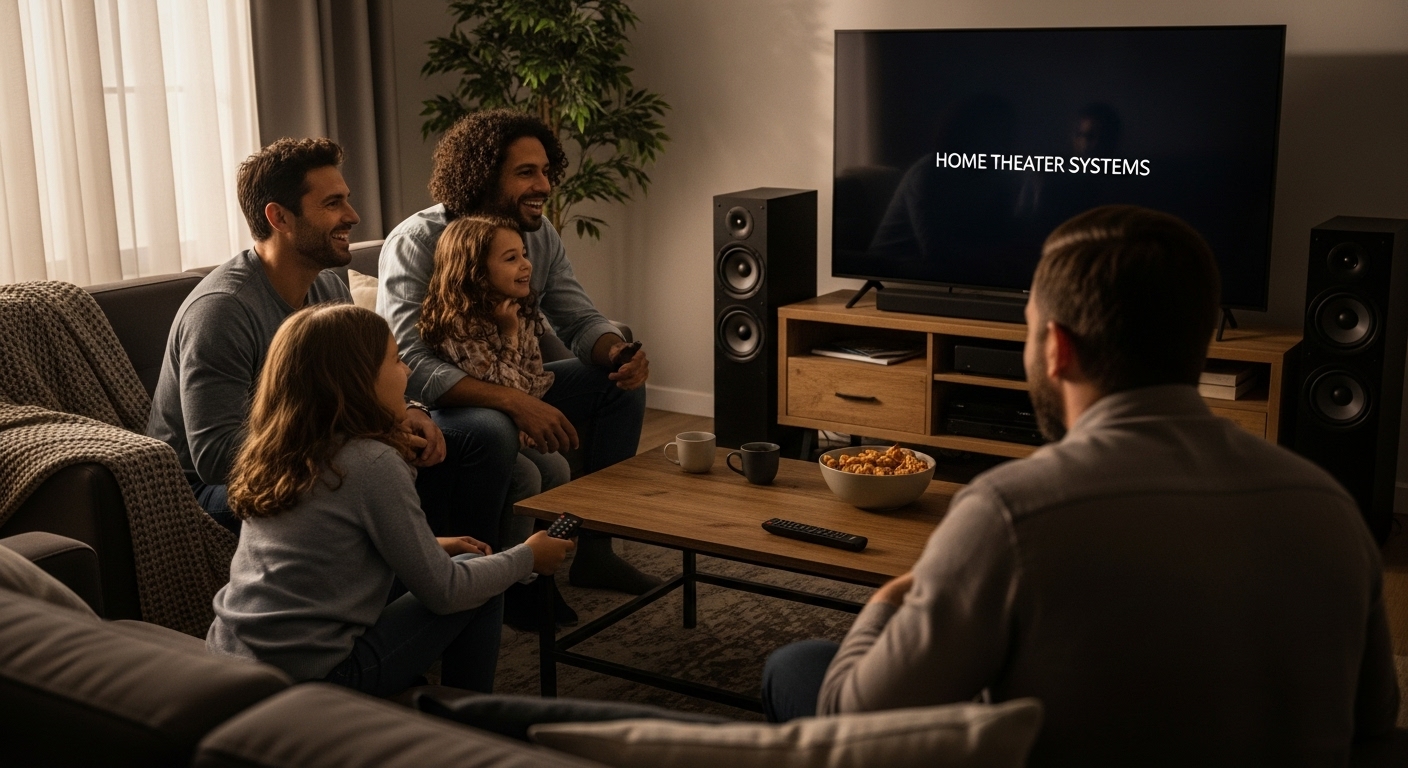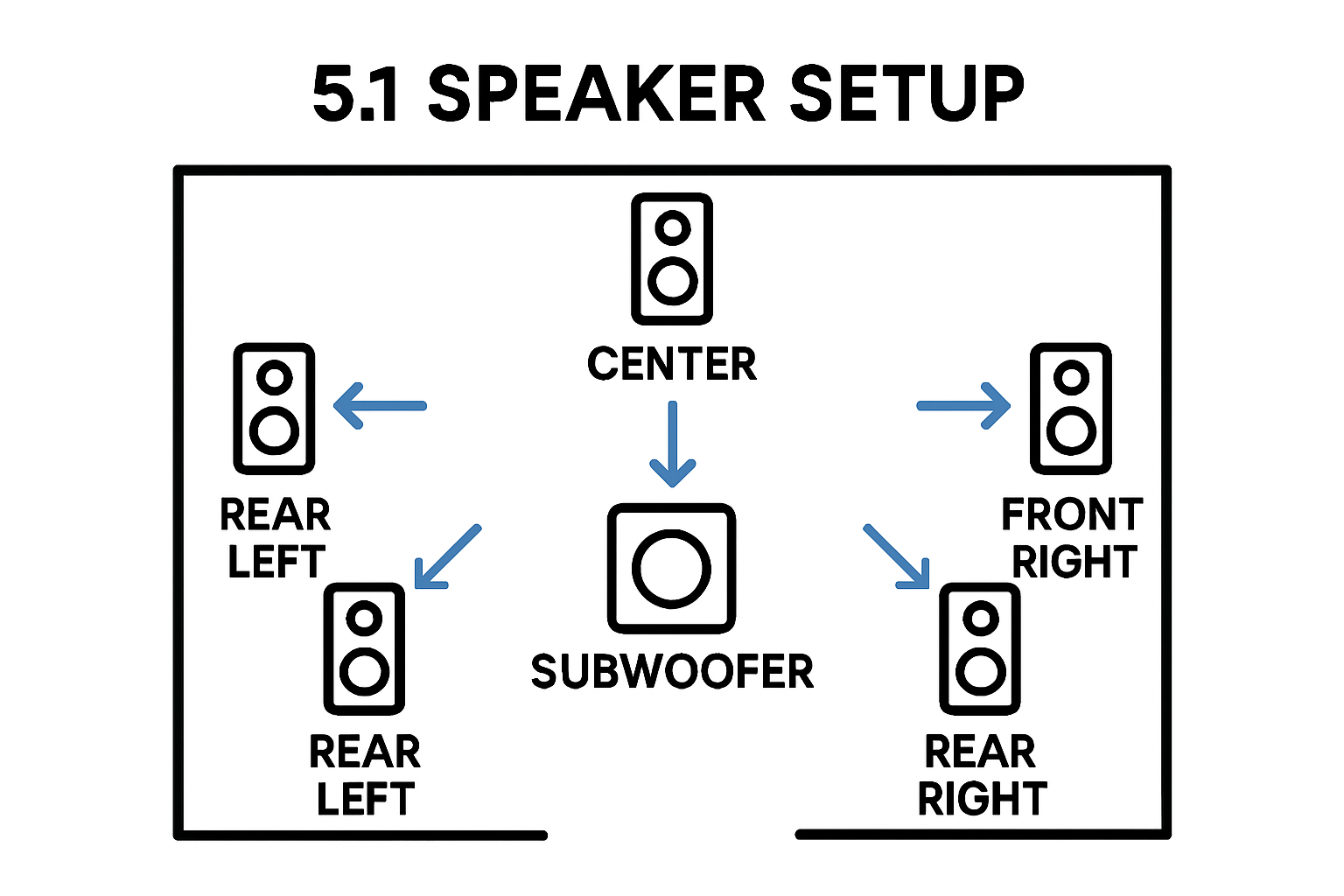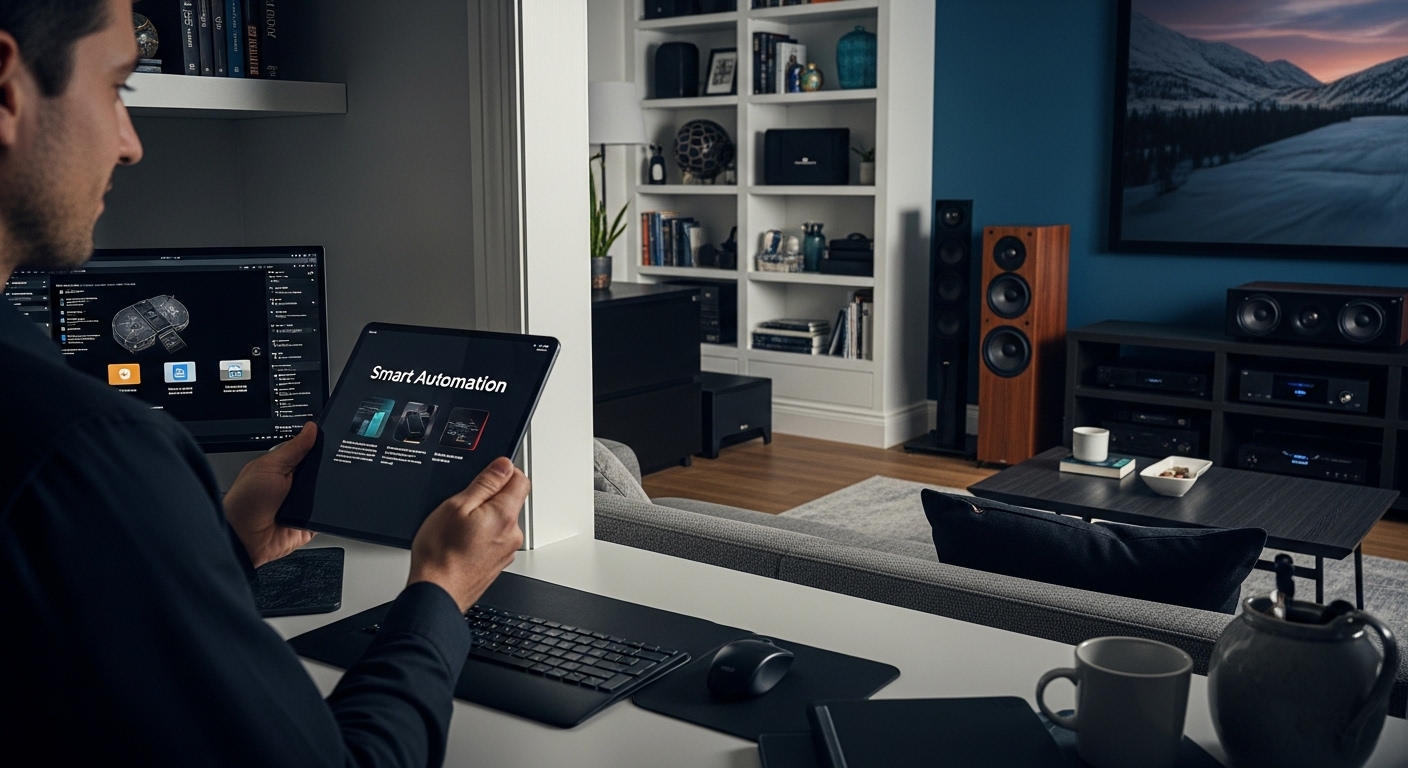Understanding What Are Home Theater Systems
- garygarihanjr
- Sep 17
- 9 min read

The idea of building a personal movie theater at home sounds over the top for most people. Nearly everyone pictures giant screens and racks of expensive equipment. But the coolest part is how accessible and advanced these setups have become—the global home theater market is set to hit $66.16 billion by 2027. With new wireless tech and smart automation, even a simple living room can now deliver cinema-level sound and picture that feels nothing like yesterday’s clunky surround sound.
Table of Contents
Quick Summary
Takeaway | Explanation |
Invest in quality components for better experiences | High-resolution displays and surround sound systems enhance viewing and listening experiences significantly. |
Embrace smart technology for convenience | Integrating smart features simplifies the control of home theater systems and improves user experience. |
Pay attention to speaker placement for optimal sound | Proper positioning of speakers creates a more immersive audio experience, essential in home theater design. |
Consider potential property value enhancement | A well-installed home theater system can make a property more attractive to prospective buyers, increasing its market value. |
Stay updated on trends for modern efficiency | Awareness of innovations like wireless setups and energy-efficient components can improve system performance and sustainability. |
Defining Home Theater Systems: Key Components Explained
A home theater system transforms your living space into a personal entertainment sanctuary, delivering cinema-quality audio and visual experiences right in the comfort of your home. These sophisticated setups blend advanced technology and strategic speaker placement to recreate the immersive atmosphere of a professional movie theater.
The Core Audio Visual Components
At its foundation, a home theater system consists of several critical components working in seamless harmony. The centerpiece is typically a large flat-screen television or projection system, which serves as the primary visual display. Modern systems often utilize high-resolution 4K or 8K screens that provide extraordinary picture clarity and depth.
The audio system represents another crucial element. According to Energy Star, a typical setup includes multiple speakers strategically positioned to create an immersive soundstage. This typically involves:

Front left and right speakers
Center channel speaker for dialogue clarity
Rear surround speakers
Subwoofer for deep bass frequencies
Signal Processing and Integration
The receiver acts as the central nervous system of a home theater setup, managing audio and video signals from various input sources. This component routes signals from devices like streaming players, game consoles, cable boxes, and Blu-ray players, while simultaneously processing and distributing sound through connected speakers.
Modern home theater systems increasingly incorporate smart technology, allowing seamless wireless connectivity and integration with home automation platforms. These advanced systems enable users to control multiple entertainment and audio components through a single interface, creating a more streamlined and user-friendly experience.
Understanding the intricate interplay between visual, audio, and signal processing components is key to appreciating the sophisticated engineering behind home theater systems.
To help readers quickly grasp the different components and their purposes, here’s a table summarizing the key core audio and visual elements that make up a home theater system.
Component | Purpose |
Display (TV or Projector) | Provides the primary visual image, often in 4K/8K quality |
Front Left and Right Speakers | Delivers main stereo sound and directional audio effects |
Center Channel Speaker | Ensures clear dialogue and central audio elements |
Rear Surround Speakers | Produces ambient and background effects for immersive sound |
Subwoofer | Adds deep bass and low-frequency effects |
Receiver | Manages and distributes both audio and video signals |
The Importance of Home Theater Systems in Modern Homes
Home theater systems have evolved from luxury accessories to essential entertainment infrastructure in contemporary residential spaces. These sophisticated technological ecosystems represent more than just audio-visual equipment they are gateways to immersive experiences that transform how families and individuals consume media and spend leisure time.
Entertainment and Social Connectivity
In an era of increased digital connectivity, home theater systems serve as central gathering points for social interaction. According to Business Research Company, the home theater market is projected to reach $66.16 billion by 2027, reflecting their growing significance in modern living spaces. These systems create environments where families and friends can share memorable viewing experiences without leaving home.
Key social benefits include:
Creating shared entertainment experiences
Facilitating family bonding through collective media consumption
Providing comfortable alternative to public theaters
Technology and Lifestyle Enhancement
Beyond entertainment, home theater systems represent significant lifestyle investments. They integrate advanced technologies that enhance living spaces, offering seamless connections between audio-visual components and smart home ecosystems. Modern systems are not just about sound and picture quality but about creating personalized, intelligent entertainment environments.
The technological sophistication of contemporary home theater systems enables:
Wireless connectivity across multiple devices
Intelligent room calibration for optimal sound
Integration with voice control and home automation platforms
Economic and Property Value Considerations
Home theater installations can substantially increase residential property value. Potential homebuyers increasingly view comprehensive entertainment systems as desirable features, viewing them as indicators of a well-maintained and technologically advanced home. Professional installations that demonstrate thoughtful integration of audio-visual technologies can differentiate properties in competitive real estate markets.
The investment in a high-quality home theater system transcends mere entertainment it represents a strategic enhancement of living spaces that combines technological innovation, social connectivity, and personal comfort.
How Home Theater Systems Create Immersive Experiences
Immersive experiences represent the pinnacle of home entertainment technology, transforming passive viewing into a multisensory journey that transports viewers beyond the physical constraints of their living spaces. Home theater systems leverage sophisticated audio-visual technologies to simulate professional cinema environments with remarkable precision and emotional impact.
Sound Staging and Spatial Audio
The foundation of immersion lies in advanced sound engineering. According to IEEE Spectrum, spatial audio technologies simulate how sound waves naturally interact with human hearing, creating three-dimensional soundscapes that trick the brain into perceiving audio from multiple directions. This intricate acoustic engineering goes far beyond traditional stereo sound, generating a sense of depth and movement that makes viewers feel embedded within the narrative.
Key elements of spatial audio include:
Precise speaker positioning
Advanced sound wave manipulation
Dynamic audio frequency management
Multi-channel sound processing
Visual Technologies and Sensory Engagement
Modern home theater systems extend immersion through cutting-edge visual technologies. High-resolution displays with 4K and 8K capabilities deliver unprecedented image clarity, while high dynamic range (HDR) technologies provide extraordinary color depth and contrast. These visual enhancements work in concert with sophisticated audio systems to create a comprehensive sensory experience that feels remarkably lifelike.
Technological features enabling visual immersion involve:
Ultra-high resolution displays
Wide color gamut technologies
High dynamic range rendering
Advanced projection mapping techniques
Psychological Impact of Immersive Experiences
Beyond technical specifications, immersive home theater systems tap into fundamental human psychological responses. By carefully orchestrating audio-visual stimuli, these systems create emotional resonance that transcends traditional entertainment boundaries. The seamless integration of sound, light, and visual elements can trigger profound sensory and emotional engagement, transforming media consumption into deeply personal experiences.
The true magic of home theater systems lies not just in technological sophistication but in their ability to blur the boundaries between physical reality and narrative worlds, offering viewers transportive experiences that challenge perceptual limitations.
Exploring Smart Automation in Home Theater Systems
Smart automation represents the cutting edge of home theater technology, transforming traditional entertainment systems into intelligent, responsive environments that adapt seamlessly to user preferences and technological ecosystems. These advanced systems go beyond simple remote control functionality, integrating sophisticated sensors, artificial intelligence, and network connectivity to create truly personalized entertainment experiences.

Integrated Control and Connectivity
According to California State University research, modern home theater automation systems leverage microprocessor technologies to enable comprehensive device management. These systems allow users to control multiple components through unified interfaces, connecting audio-visual equipment, lighting, temperature, and sound systems into a cohesive, intelligently managed network.
Key automation capabilities include:
Centralized control through smartphone applications
Voice-activated commands
Automatic scene and preset configurations
Intelligent device interconnectivity
Adaptive Technology and User Experience
Smart home theater systems utilize advanced algorithms and machine learning to understand and anticipate user preferences. These technologies analyze viewing patterns, adjust audio-visual settings in real-time, and create personalized entertainment environments that respond intuitively to individual user behaviors.
Technological features enhancing user experience involve:
Personalized sound and visual calibration
Automatic content recommendations
Energy-efficient power management
Seamless device synchronization
Security and Network Integration
Beyond entertainment, smart home theater systems incorporate robust security protocols that protect network integrity while providing sophisticated connectivity. Advanced systems can detect unauthorized access, manage device permissions, and ensure secure communication between different technological components.
The evolution of smart automation in home theater systems represents more than technological innovation it signifies a fundamental reimagining of how individuals interact with entertainment technologies, creating spaces that are responsive, intelligent, and tailored to individual preferences.
Trends and Innovations in Home Theater System Design
Home theater system design continues to evolve dramatically, driven by technological advancements and changing consumer expectations. These innovations reflect a profound shift from traditional audio-visual setups toward more intelligent, adaptable, and personalized entertainment environments that seamlessly integrate with modern lifestyles.
Wireless and Modular Technologies
Contemporary home theater systems are increasingly characterized by wireless connectivity and modular design, eliminating complex cable networks and offering unprecedented flexibility. According to ResearchGate, the transition from traditional surround sound to smart speaker configurations represents a fundamental reimagining of audio experiences.
Key technological innovations include:
Seamless wireless speaker integration
Compact, adaptable speaker designs
Multi-room audio synchronization
Bluetooth and Wi-Fi enabled components
Artificial Intelligence and Personalization
Artificial intelligence has become a transformative force in home theater system design, enabling unprecedented levels of personalization and user interaction. Modern systems leverage machine learning algorithms to analyze viewing preferences, automatically adjust audio-visual settings, and provide intelligent content recommendations that adapt to individual user behaviors.
Advanced personalization features encompass:
Adaptive sound profile calibration
Predictive content suggestions
Voice-activated control interfaces
Intelligent power and performance management
Sustainability and Energy Efficiency
Emerging home theater system designs prioritize environmental sustainability and energy efficiency. Manufacturers are developing components that minimize power consumption, utilize recyclable materials, and integrate smart energy management technologies that reduce overall ecological impact without compromising performance quality.
The future of home theater systems extends beyond mere technological capability it represents a holistic approach to entertainment that balances cutting-edge innovation, user experience, and environmental responsibility.
This table outlines key trends and innovations in home theater design, summarizing how each trend impacts system performance and user experience.
Trend/Innovation | Description | User Benefit |
Wireless & Modular Technologies | Wireless, flexible speaker systems and simpler setups | Easier installation, room flexibility |
Artificial Intelligence | Machine learning for personalization and automation | Tailored content, intuitive control |
Sustainability & Energy Efficiency | Low power consumption, recyclable materials | Reduced environmental impact |
Ready to Turn Home Theater Dreams Into Reality?
Struggling to create a true entertainment sanctuary at home? The article highlighted complex challenges like intricate audio calibration, perfect speaker placement, and the overwhelming options in smart automation. It is easy to feel lost when you want seamless integration of 4K visuals, immersive surround sound, and centralized control in one luxury space. That is where expertise matters most and why so many Houston homeowners trust professionals dedicated to custom design and flawless results.

Elevate your lifestyle and maximize your investment by choosing Techology Experts. Discover how our team can deliver a bespoke home theater installation solution tailored to your dreams. Schedule your consultation today and see why true cinema-quality immersion truly starts with the right specialist. Spots fill quickly, so now is the perfect time to bring your vision to life.
Frequently Asked Questions
What is a home theater system?
A home theater system is a setup that transforms a living space into an entertainment center, providing cinema-quality audio and visual experiences. It typically includes a large flat-screen TV or projector, multiple speakers, and a receiver to manage audio and video signals.
What are the key components of a home theater system?
Key components of a home theater system include a high-resolution television or projector, front left and right speakers, a center channel speaker, rear surround speakers, and a subwoofer for deep bass. The receiver is crucial for managing audio and video signals from multiple devices.
How do home theater systems enhance the viewing experience?
Home theater systems enhance the viewing experience by creating an immersive environment through advanced sound and visual technologies. Spatial audio creates three-dimensional soundscapes, while high-resolution displays provide exceptional image clarity, making viewers feel like they are part of the action.
What are the benefits of integrating smart automation in home theater systems?
Integrating smart automation allows for centralized control of audio-visual equipment, lighting, and temperature through smartphone applications or voice commands. It enhances user experience by adapting to preferences and providing personalized entertainment environments.
Recommended
Comments